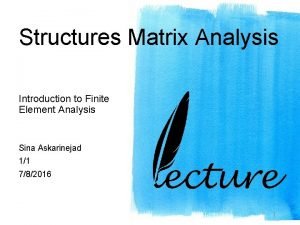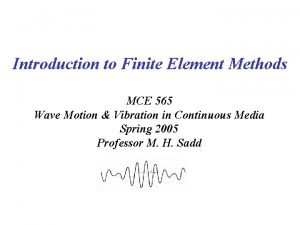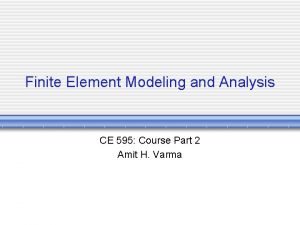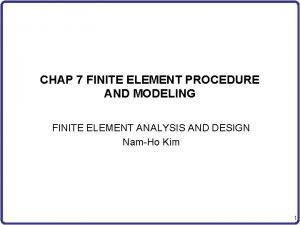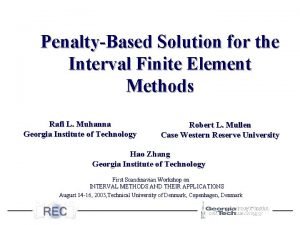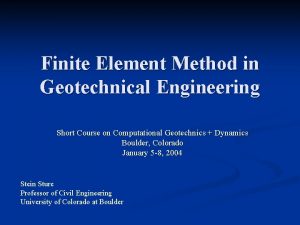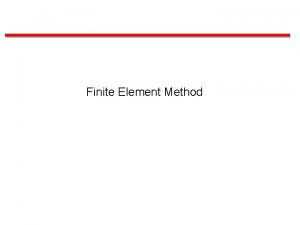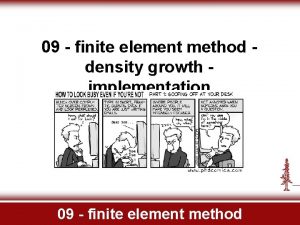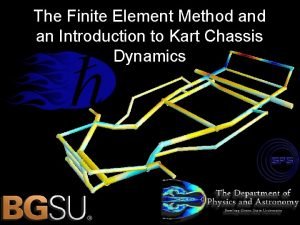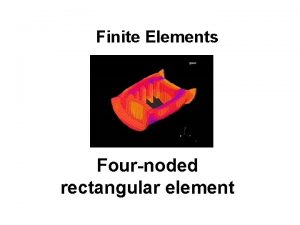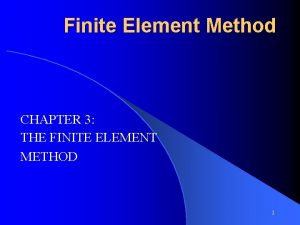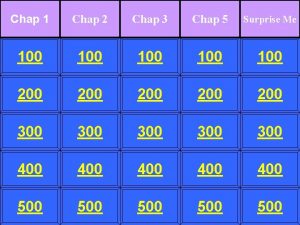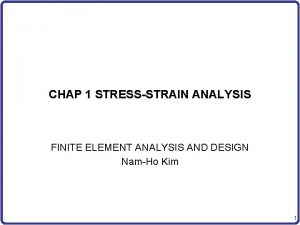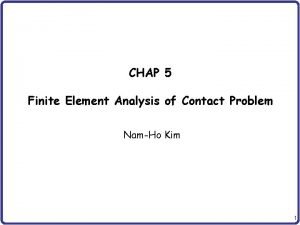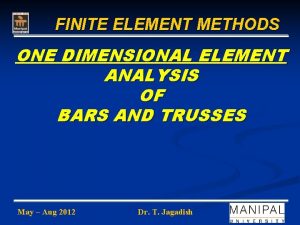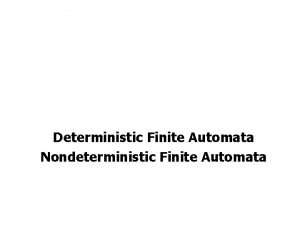CHAP 0 MATHEMATICAL PRELIMINARY FINITE ELEMENT ANALYSIS AND
















![MINIMUM PRINCIPLE • Function in quadratic form – [A]: stiffness of the structure, {x}: MINIMUM PRINCIPLE • Function in quadratic form – [A]: stiffness of the structure, {x}:](https://slidetodoc.com/presentation_image_h2/595d17653be1b4b6d279830b4cde2c0e/image-17.jpg)
![Homework #1 5. For the two matrices [A] and [B] in Problem 2, answer Homework #1 5. For the two matrices [A] and [B] in Problem 2, answer](https://slidetodoc.com/presentation_image_h2/595d17653be1b4b6d279830b4cde2c0e/image-18.jpg)

- Slides: 19

CHAP 0 MATHEMATICAL PRELIMINARY FINITE ELEMENT ANALYSIS AND DESIGN Nam-Ho Kim 1

MATHEMATICAL PRELIMINARY • Vector – a collection of scalars, defined using a bold typeface with braces • Matrix – a collection of vectors, defined using a bold typeface with brackets – dimension = N×K. When N = K, it is called a square matrix 2

MATRIX – Transpose of a matrix: Change of row and column – Symmetric and Skew-symmetric matrices – Identity matrix 3

VECTOR-MATRIX CALCULUS • Addition • Scalar product between two vectors (must be the same dim) • Norm (Magnitude of a vector) 4

DETERMINANT • • • Similar to the norm of a vector Only defined for a square matrix If a determinant is zero, the matrix is not invertible A matrix is singular when its determinant is zero For a 2 x 2 matrix: • For a 3 x 3 matrix 5

VECTOR-MATRIX CALCULUS cont. • Vector product – Scalar product result = scalar – Vector product result = vector 6

MATRIX-VECTOR MULTIPLICATION • Matrix Vector = Vector • Vector Matrix Vector = Scalar 7

MATRIX-MATRIX MULTIPLICATION • Matrix = Matrix • Inverse of a matrix: – A square matrix [A] is invertible, then – If a matrix is singular (|A| = 0), then the inverse does not exist 8

RULES OF MATRIX MULTIPLICATION • Associative rule: • Distributive rule: • Non-commutative: • Transpose of product: • Inverse of product: 9

MATRIX EQUATION – N unknowns (x 1, x 2, …, x. N) and N equations – unique solution if all equations are independent – Matrix form: – Solution: [A]– 1 exists or [A] is not singular 10

EIGEN VALUE AND EIGEN VECTOR • Eigen value problem : Eigen value : Eigen vector • How to solve? – {x} = {0} is a solution (trivial solution) – In order to have non-trivial solution, the determinant must be zero. – Calculate problem from this equation and calculate from the eigen value 11

EIGEN VALUE AND EIGEN VECTOR • Characteristic equation – The textbook has a solution for [A]3 x 3 case • Eigen vectors – After solving for eigen values, substitute each of them to eigen problem – Since is singular, no unique solution exists – Practice example in the textbook 12

QUADRATIC FORM • Quadratic form: quadratic function of all components • Matrix notation • Symmetric part is enough ([B] is not sym) 13

POSITIVE DEFINITE MATRIX • Positive definite • Positive semi-definite • Positive definiteness = each column of the matrix is linearly independent = the matrix is invertible = the matrix is not singular = the matrix equation has a unique solution. 14

MAXIMA & MINIMA OF FUNCTIONS • Single Variable f(x) – Taylor series expansion – In order for f to be extremum, – Condition for minima: – Condition for maxima: 15

MAXIMA & MINIMA OF FUNCTIONS cont. • Multi-Variable f(x) – Taylor series expansion – In order for f to be extremum, Hessian matrix Hij – Condition for minima: [H] is positive definite – Condition for maxima: [H] is negative definite 16
![MINIMUM PRINCIPLE Function in quadratic form A stiffness of the structure x MINIMUM PRINCIPLE • Function in quadratic form – [A]: stiffness of the structure, {x}:](https://slidetodoc.com/presentation_image_h2/595d17653be1b4b6d279830b4cde2c0e/image-17.jpg)
MINIMUM PRINCIPLE • Function in quadratic form – [A]: stiffness of the structure, {x}: displacement, {b}: applied force – Potential energy – structure is in equilibrium when F has a minimum value • Matrix equation – Solution of the matrix equation minimizes the quadratic form F. 17
![Homework 1 5 For the two matrices A and B in Problem 2 answer Homework #1 5. For the two matrices [A] and [B] in Problem 2, answer](https://slidetodoc.com/presentation_image_h2/595d17653be1b4b6d279830b4cde2c0e/image-18.jpg)
Homework #1 5. For the two matrices [A] and [B] in Problem 2, answer the following questions. (a) Evaluate the matrix–matrix multiplication [C] = [A][B]. (b) Evaluate the matrix–matrix multiplication [D] = [B][A]. 7. Calculate the inverse of the matrix 9. Solve the following simultaneous system of equations using the matrix method: 18

Homework #1 11. Find the eigen values and eigen vectors 14. A function f(x 1, x 2) of two variables x 1 and x 2 is given by (a) Multiply the matrices and express f as a polynomial in x 1 and x 2. (b) Determine the extreme (maximum or minimum) value of the function and corresponding x 1 and x 2. (c) Is this a maxima or minima? 19
 Chap chap slide
Chap chap slide Fem applications
Fem applications Non finite subordinate clause
Non finite subordinate clause Learning objectives for finite and non finite verbs
Learning objectives for finite and non finite verbs Learning objectives of non finite verbs
Learning objectives of non finite verbs Finite and non finite clause
Finite and non finite clause Finite and non finite
Finite and non finite Truss finite element analysis
Truss finite element analysis Finite element analysis
Finite element analysis Elements of mathematical economics
Elements of mathematical economics I was in that state when a chap easily turns nasty analysis
I was in that state when a chap easily turns nasty analysis Finite element method example
Finite element method example Hourglass modes finite element method
Hourglass modes finite element method Cst element
Cst element Finite element example
Finite element example Finite element
Finite element Fem geotechnics
Fem geotechnics Finite elements method
Finite elements method Finite element method
Finite element method Finite element method
Finite element method







